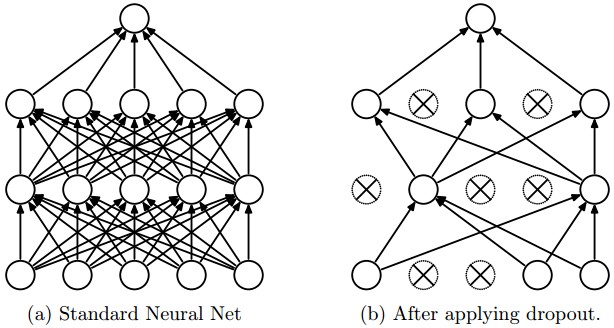20. Quiz: TensorFlow Dropout
TensorFlow Dropout

Figure 1: Taken from the paper "Dropout: A Simple Way to Prevent Neural Networks from
Overfitting" (https://www.cs.toronto.edu/~hinton/absps/JMLRdropout.pdf)
Dropout is a regularization technique for reducing overfitting. The technique temporarily drops units (artificial neurons) from the network, along with all of those units' incoming and outgoing connections. Figure 1 illustrates how dropout works.
TensorFlow provides the tf.nn.dropout() function, which you can use to implement dropout.
Let's look at an example of how to use tf.nn.dropout().
keep_prob = tf.placeholder(tf.float32) # probability to keep units
hidden_layer = tf.add(tf.matmul(features, weights[0]), biases[0])
hidden_layer = tf.nn.relu(hidden_layer)
hidden_layer = tf.nn.dropout(hidden_layer, keep_prob)
logits = tf.add(tf.matmul(hidden_layer, weights[1]), biases[1])The code above illustrates how to apply dropout to a neural network.
The tf.nn.dropout() function takes in two parameters:
hidden_layer: the tensor to which you would like to apply dropoutkeep_prob: the probability of keeping (i.e. not dropping) any given unit
keep_prob allows you to adjust the number of units to drop. In order to compensate for dropped units, tf.nn.dropout() multiplies all units that are kept (i.e. not dropped) by 1/keep_prob.
During training, a good starting value for keep_prob is 0.5.
During testing, use a keep_prob value of 1.0 to keep all units and maximize the power of the model.
Quiz 1
Take a look at the code snippet below. Do you see what's wrong?
There's nothing wrong with the syntax, however the test accuracy is extremely low.
...
keep_prob = tf.placeholder(tf.float32) # probability to keep units
hidden_layer = tf.add(tf.matmul(features, weights[0]), biases[0])
hidden_layer = tf.nn.relu(hidden_layer)
hidden_layer = tf.nn.dropout(hidden_layer, keep_prob)
logits = tf.add(tf.matmul(hidden_layer, weights[1]), biases[1])
...
with tf.Session() as sess:
sess.run(tf.global_variables_initializer())
for epoch_i in range(epochs):
for batch_i in range(batches):
....
sess.run(optimizer, feed_dict={
features: batch_features,
labels: batch_labels,
keep_prob: 0.5})
validation_accuracy = sess.run(accuracy, feed_dict={
features: test_features,
labels: test_labels,
keep_prob: 0.5})SOLUTION:
keep_prob should be set to 1.0 when evaluating validation accuracy.Quiz 2
This quiz will be starting with the code from the ReLU Quiz and applying a dropout layer. Build a model with a ReLU layer and dropout layer using the keep_prob placeholder to pass in a probability of 0.5. Print the logits from the model.
Note: Output will be different every time the code is run. This is caused by dropout randomizing the units it drops.
Start Quiz:
User's Answer:
(Note: The answer done by the user is not guaranteed to be correct)